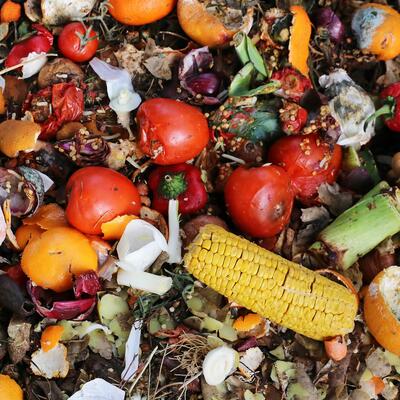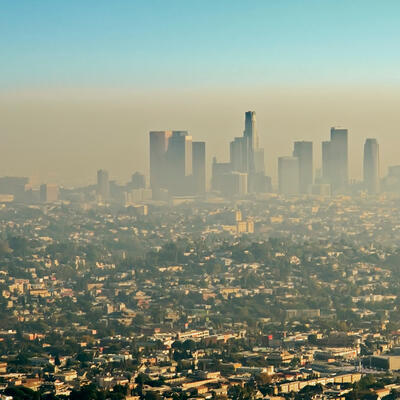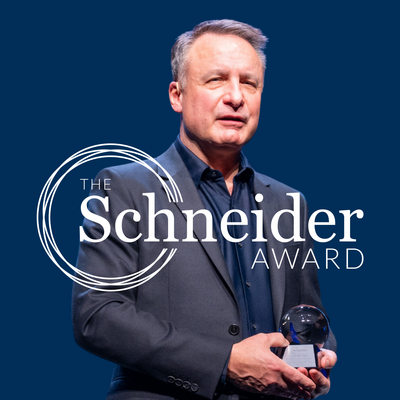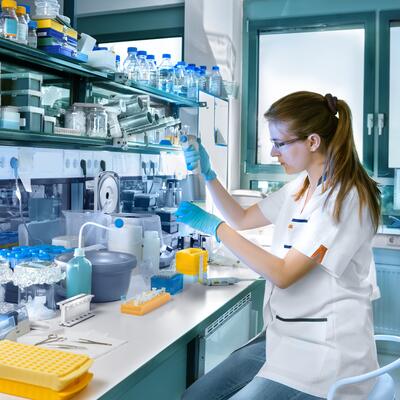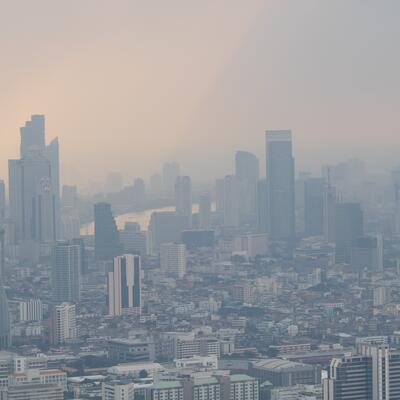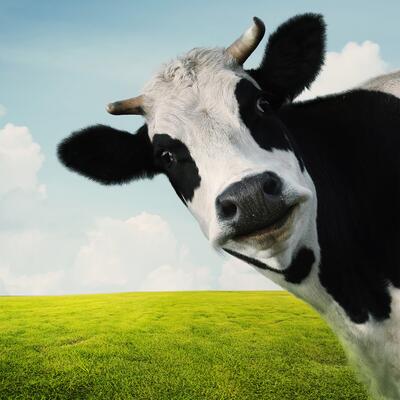
Super Pollutants: The Hidden Half of Global Warming
Guests

Ilissa Ocko

David Kanter

Millie Chu Baird
Summary
About half of global warming is driven by pollutants that aren’t carbon dioxide. There are several of these “super pollutants” — so named because of their outsized ability to increase global temperature even in very small amounts. They include methane, nitrous oxide, tropospheric (or near ground-level) ozone, black carbon and f-gasses.
Because CO2 can last in the atmosphere for thousands of years, we have rightly focused on mitigating and lowering those emissions. Yet because climate change has been driven by the buildup of CO2 over time, even stopping those emissions tomorrow won’t immediately slow warming. By contrast, most super pollutants last for days to maybe a decade. This is good news, as Ilissa Ocko, senior climate scientist at Climate Spark Solutions, explains: “The moment we stop replenishing the atmosphere with those emissions, we can almost immediately eliminate their warming impact on the climate.”
Methane, for example, is about 80 times more potent at warming the climate than carbon dioxide over 20 years. But it only stays in the atmosphere for roughly a decade. There are now multiple satellites tracking methane emissions and making their data available to the public, including MethaneSAT, led by the Environmental Defense Fund (EDF). There are now multiple satellites tracking methane emissions and making their data available to the public, including MethaneSAT, led by the Environmental Defense Fund (EDF).
Millie Chu Baird of EDF says the idea is to help emitters know about their own contributions to atmospheric methane and to give more teeth to regulations of the gas.
“There's no more ability to just hide, deny, and keep reporting at this low level of estimates. It's like literally we'll be able to track how you're doing against these public commitments. And so it has changed the tenor of the conversation,” she says.
Minimizing leaks from oil and gas production, which is what MethaneSAT is focused on, is an easier sell because there’s a profit incentive.
“The methane conversation with oil and gas companies is like, this is a waste product. It's commonly understood that with available technology, you can reduce your emissions by 75%. Sixty percent at no net cost because if you reduce the leaks, you can sell the product,” Baird says.
But reducing emissions of nitrous oxide, which largely comes from synthetic fertilizers used to grow half the world’s food, is a harder problem to solve.
“ It's always difficult from an environmental perspective to do policy in the agricultural sector because pollution there is much more diffuse,” says David Kanter, an associate professor of environmental studies at NYU. When it comes to the use of fertilizer, “there are many parts of the world [with] a huge amount of over-application, either because the fertilizer is subsidized or simply because maximizing yield is the absolute top priority.”
More precise methods of applying fertilizer or delayed-release formats could help with this. There’s even new technologies exploring using gene-edited microbes to fix nitrogen directly in the root zone of plants. And we do need to address the problem of excess in the nitrogen cycle because it leads to a series of cascading effects.
Because of the unique chemistry of the nitrogen cycle, it can go on a “journey of environmental destruction," Kanter says. “It can first make air pollution worse, it can then be transformed into nitrate and pollute water. So high nitrate levels are linked with increased risk of colon cancer, blue baby syndrome, algae blooms that lead to massive fish kills, and then that same atom of nitrogen that has been in air pollutant, and then a water pollutant can be transformed yet again to nitrous oxide, where it contributes to climate change and ozone depletion.”
But the good news is “if we manage nitrogen better, you get a whole host of co-benefits and human health benefits as a result.”
Episode Highlights
1:41 - Ilissa Ocko on what is a super pollutant
7:13 - Ilissa Ocko on stopping methane pollution
11:24 - Ilissa Ocko on how to address super pollutants
26:36 - David Kanter on nitrous oxide
37:52 - David Kanter on unintended consequences
40:41 - David Kanter on what we do from here
47:54 - Millie Chu Baird on why methane tracking technology is necessary
52:37 - Millie Chu Baird on why data specificity can make difference
What Can I Do?
Resources From This Episode (2)
Full Transcript
Note: Transcripts are generated using a combination of automated software and human transcribers and may contain errors. Please check the actual audio before quoting it.
Ariana Brocious: I’m Ariana Brocious.
Kousha Navidar: I’m Kousha Navidar.
Ariana Brocious: And this is Climate One.
[music change]
Ariana Brocious: Kousha, when you think of greenhouse gases, what comes to mind?
Kousha Navidar: You mean, before we started working on this episode? I think I would have just said carbon dioxide. Then I guess if you pressed me a little more, I might have come up with methane. I mean, I know there are like, a billion cows belching the stuff…
Ariana Brocious: Yeah, and I admit I thought pretty much the same thing. SO much of the climate conversation is focused on reducing emissions of carbon dioxide, or CO2. And rightly so. Because CO2 has caused over half of the global warming we’re experiencing today. But what about the other half?
Kousha Navidar: Need I repeat…Methane! Cows!
Ariana Brocious: Well, partial credit. Methane - from cows, landfills, the fossil fuel industry, and a few other sources – is the next biggest contributor to climate change after CO2. But methane, while important, is only one of several so-called super pollutants that account for nearly half of global warming.
Kousha Navidar: Right. So it’s wild that they aren’t talked about more. And as I’ve been learning, these super pollutants aren’t just bad for our climate systems – they’re also harmful for air quality. So reducing them has multiple benefits. And more good news: most of the super pollutants responsible for warming our planet don’t stick around in the atmosphere very long. So if we deal with them today, we’ll see some reduction in global warming pretty quick.
I got a crash course in these Earth-warming agents from Ilissa Ocko, Senior Climate Scientist at Spark Climate Solutions.
Ilissa Ocko: Super pollutants are climate warming agents that are far more powerful than carbon dioxide, so we actually emit far less of them than carbon dioxide. But because they're super at trapping heat or warming the climate, they pack a bigger punch. And so they're actually driving half of the warming we're experiencing today. And so I often even refer to super pollutants as the other half of warming that isn't from carbon dioxide.
Kousha Navidar: Oh wow. So it's like less in the atmosphere, but like each molecule packs a bigger punch in terms of climate impact, right.
Ilissa Ocko: Yeah, there's like a hundred times less amount of them in the atmosphere. Like, so much less which is also why it's so hard to remove them 'cause they're just so dilute in the atmosphere. But yeah, each one is just so much more effective at warming the climate than CO2. So even though there's so much less, they end up accounting for half of today's warming, which is something that most people have no idea about.
Kousha Navidar: Yeah. And there's a whole bunch of 'em, right? It's not just one kind of super pollutant. What do they all have in common?
Ilissa Ocko: Yeah, so super pollutants are comprised of a mix of different greenhouse gases that trap heat or gases that form greenhouse gases in the atmosphere, and particles that absorb sunlight. But something that they, they pretty much all have in common is that many don't last long in the atmosphere. They also degrade air quality while they're there. So reducing their emissions is an opportunity to immediately slow warming and clean our air in ways that CO2 on its own cannot. CO2 is what we call a long-lived greenhouse gas. In fact, some CO2 can last in the atmosphere for thousands of years. And so this means two things. One, that preventing further emissions is essential for long-term climate stability. So we have rightfully focused on carbon dioxide mitigation for decades.
Second, that today's warming impact from CO2 is largely from its buildup over time. And what that means is that reducing CO2 emissions won't immediately slow down warming. And so this brings us back to why super pollutant action is such an important compliment to CO2 action because a lot of super pollutants last for days at most to maybe a decade or so, and so that half of warming that they're contributing to today is from recent emissions. So the moment we stop replenishing the atmosphere with those emissions, we can almost immediately eliminate their warming impact on the climate.
Kousha Navidar: Yeah, that makes total sense. Let's walk through them a little bit. I'm imagining this like a family of gases where each one kind of has a different character. I wanna learn about these super pollutants. Let's start with methane. So the main ingredient in what a lot of people call natural gas. Why is methane concerning?
Ilissa Ocko: So methane is the super pollutant with today's biggest impact, which is why next to CO2, it's what you tend to hear about the most. Methane emissions are responsible for about 30% of today's warming, mostly from livestock, oil and gas operations and landfills. Methane is found naturally in the atmosphere, but human actions are creating more opportunities for it to form and escape, like you said, from natural gas. And so we've actually seen the amount of methane in the atmosphere increase by more than double, like two and a half times more methane in the atmosphere today than we had in pre-industrial times. But because it only lasts for around a decade and we already have the tools to slash emissions in half, many of which are largely affordable, cutting methane is also considered the fastest single way to slow warming right now.
Kousha Navidar: Okay. And, and you said that it comes from natural places. Can you tell me more, like where do I see methane? You mentioned landfills. You mentioned like garbage being put on top of each –
Ilissa Ocko: Yeah, so it's, yeah. When you're not familiar with how methane forms, it seems like this really random list of sources. It's like it's coming from cows, but it's coming from oil operations. But really what they all have in common is that. Methane is formed from the breakdown of organic matter, which is like plants and animals. So basically when you have bacteria or even high temperature and pressure underground that are breaking down this organic matter, methane is formed. And that's what, you know, creates a lot of our fossil fuels and natural gas. And we also see that when we bury trash in landfills, for example, but then also underwater. And this is why we see a lot of natural methane coming from wetlands, you have vegetation that's just decomposing underwater, especially in warm places. And that's why this can also be, you know, in wastewater or in rice fields, rice patties, because you are growing the plants in a flooded field.
Kousha Navidar: So it sounds like this is a, a, a natural decomposition byproduct is kind of how I would I describe it.
Ilissa Ocko: Yes,
Kousha Navidar: So I'm not a chemistry guy, but I do love physics and I feel like short of stopping things from decomposing, which runs against like a law of thermodynamics… what are the easiest ways to stop methane from polluting the air?
Ilissa Ocko: Yeah, number one, if we were to stop all fossil fuel extraction activities, we would prevent a lot of this methane that was produced deep underground from going back into the atmosphere. I mean, it should stay underground for thousands, millions of years. But it's not because we're taking it out. But also just not having, for example, as much livestock, like let's say having more efficient livestock that can more productively produce milk, let's say. So you have less cattle, but still the same amount of milk, you'll have less digestion producing methane. For landfills you divert that organic matter somewhere else, you don't let it end up in a landfill. You compost it, which means you're basically giving it the oxygen that it needs to fully decompose, and then you can use that for soil, for example.
Kousha Navidar: And so you were saying as well, if we stop methane from leaking into the atmosphere, a huge part of the problem goes away pretty quickly. Right.
Ilissa Ocko: Yes. Yes. Because that methane that's causing 30% of today's warming is really from methane we've emitted over the past couple of decades.
Kousha Navidar: Interesting. Let's turn to ozone. So this is number two of the five we're gonna talk about. I grew up thinking ozone was our friend. In fact, it shields pretty much every living thing from the sun's ultraviolet radiation. And anyone who was a kid from the eighties or nineties knows about the ozone layer opening up and, and the loss of ozone was a huge global concern. So, Illissa, help me understand why are climate scientists now worried about ozone accumulating?
Ilissa Ocko: Yeah, so there's the good ozone and the bad ozone and it really depends on where you are in the atmosphere. And so the good ozone is upper atmosphere stratosphere for those familiar with the atmosphere layers. And that ozone naturally forms and is really essential to blocking harmful UV radiation from penetrating down to the surface. So that's the good ozone. The bad ozone is, and it's the same molecule, but that molecule is also toxic. So when that ozone forms and it can form through a number of different pathways, and some of our emissions of different gases into the atmosphere are triggering the formation of ozone down here. We call that tropospheric ozone. It's toxic to humans and plants, and it's also a greenhouse gas.
Kousha Navidar: I've heard you mention that this, like near ground level ozone is responsible for about a quarter of global warming. That's a huge amount, but it's not covered by the Paris Agreement. Why not?
Ilissa Ocko: The Paris Agreement and other climate targets are focused on reducing our emissions of climate warmers, rightfully so, 'cause that's what we directly effect. tropospheric ozone is not emitted, it is formed in the atmosphere. So it's been left out of a lot of these really important climate treaties and agreements and whatnot, including in the Paris Agreement because what's forming the tropospheric ozone like carbon monoxide, for example, and volatile organic compounds, also known as VOCs.those are really harmful air pollutants, but they aren't major greenhouse gases, so they're not covered by the Kyoto Protocol, the Paris Agreement that is focusing on greenhouse gases that we emit. So that's a major gap in climate policy that needs to be addressed because carbon monoxide and volatile organic compounds are contributing to around 12% of the warming we're experiencing today. That's more than nitrous oxide. That's more than fluorinated gases. We'll talk about those next, but, you know, this is a considerable amount of today's warming that we're getting from these pollutants that aren't traditional greenhouse gases, but need to be addressed. If we are to, curb the entirety of climate
Kousha Navidar: So what do we do about it?
Ilissa Ocko: I mean, we really need to understand better where they're coming from. We have some data that shows that carbon monoxide and volatile organic compounds mostly come from industry and transportation and buildings. A lot of them are addressed by air quality measures and because a lot of, let's say, carbon monoxide, comes from the same sources as CO2, it's very possible that decarbonization will reduce a lot of carbon monoxide emissions as well. But all of this needs to be assessed in a very holistic way, and it has not yet.
Kousha Navidar: Let's go to another one. Black carbon, also called soot, but it sounds like those are separate. Can you quickly tell me about black carbon? Where does it come from?
Ilissa Ocko: Black carbon is a very interesting super pollutant. If we played a game of like, which one does not match the rest, black carbon would be that because it is not a gas, it doesn't form greenhouse gases. It is a solid particle that absorbs sunlight. It's contributing to around 5% of the warming we're experiencing today. Its main sources are traditional cooking stoves, transportation, open fires. You can visibly see it. It's black, which is why a lot of people think of black carbon as soot, and it is the main component of soot. Soot is comprised of more particulates than just black carbon. But what, when you look at soot and you see that big truck go by and that puff of black smoke comes out, what you are seeing is black carbon. It can also be deposited on snow and ice in different parts of the world, and it speeds up snow melts, so then it ends up having even more warming from that as well. it's also a major health concern. It is a core component of PM 2.5, which is fine particulates. They're very harmful for human health when you breathe them in. So it's a major climate concern and also an air quality concern.
Kousha Navidar: And what do we do about this one?
Ilissa Ocko: So there are certain things that are very impactful and we've already started doing, like diesel engines for example. There are particulate filters, we can transition to cleaner fuels. That's sort of a low hanging fruit for black carbon action. And another one is these traditional cooking stoves that are just really bad for human health. They're responsible for millions of deaths globally every year. And so it's a major health issue and a lot of different organizations are trying to get the 2 billion people worldwide who rely on primitive forms of cooking and heating to switch to cleaner cook stoves. And that also will drive down black carbon emissions, which would be really helpful.
Kousha Navidar: So we got two more. Let's go through them quickly. Nitrous oxide, tell me about that one.
Ilissa Ocko: So nitrous oxide or N2O also contributes around 5% of today's warming. And this time it's a long-lived greenhouse gas, so it's similar to carbon dioxide in that it can last in the climate system for a while. The main source of N2O from human actions is nitrogen fertilizers that are used in agriculture. but there also is a good amount of N2O that's coming from industrial processes. Like when we make different kinds of fabrics for cars or for clothing, we emit N2O into the atmosphere and there's some really good cost effective options to just reduce those emissions entirely, like by 95%. So that's really exciting opportunity that people are working on.
Kousha Navidar: later in this episode we'll talk to an expert about the challenges of reducing nitrous oxide from fertilizers while still meeting the global demand for food. , And so let's go on to the last one, the fifth and final group in the Super Pollutants Club. They're called F Gasses. Why the f? What is it?
Ilissa Ocko: Yeah, so F stands for fluorinated. They're also sometimes called halogenated gases 'cause it's kind of, if you remember your periodic table, like all the way, the column on the right side –
Kousha Navidar: I barely do.
Ilissa Ocko: – which is like inert, inert gases or whatnot. So this one is also different than the rest in that, this is the one category that's not natural. We do not find these gases naturally in the atmosphere. We make them, they are entirely synthetic. They make up around 5% of today's warming. And they're designed purposely to help us, for example, through enabling refrigerators and air conditioners, um, and also cooling our electronics. And so fluorinated gases include, you may be familiar with CFCs chlorofluorocarbons from refrigerators in the fifties.
Kousha Navidar: Yes.
Ilissa Ocko: So they're not just powerful and long-lived greenhouse gases, but they also were major destroyers of the good ozone, the ozone layer in the upper atmosphere that protects us. And so we've been phasing out these older types of f gasses mostly through an international agreement called the Montreal Protocol. But their main replacement gasses, which are called HFCs, which stands for hydrofluorocarbons, those ones were not affecting the ozone layer, but they're potent greenhouse gases. So now we are starting to phase those down as well through the Kigali amendment to the Montreal Protocol, which was a really exciting development from a few years ago. And these fluorinated gases, the HFC, these are short-lived. So they're not long-lived in the atmosphere. But if we didn't take care of them, they were expected to balloon outta control and contribute substantially to warming in the future. So we are now trying to address that issue. Is there more to be done? Absolutely. We could move a lot faster, but it's exciting to have these international agreements in place.
Kousha Navidar: Okay, so, with aplomb, you just walked us through the five in the super pollutant club. There's methane, ozone, black carbon, nitrous oxide, and F gasses. So, of the members of the Super Pollutants Club, which one are you personally most concerned about?
Ilissa Ocko: Oh. So, you know, it's like you don't have like a favorite child 'cause they're all so unique and special in their own way. And they honestly all and destructive. And, and I, but I think about it in terms of like. The opportunities we have with them. So it's like glass half full, glass half empty. So like glass half empty. They're all destructive and worrisome, glass half full. Because all of these super pollutants have been largely neglected in climate policy, they also can be considered this like untapped opportunity to curb climate change. They're responsible for more than half of today's warming, but they've only received a few percent of climate funding. So it's like there's a lot we can do to accelerate efforts to reduce them. I think one that is a really intriguing opportunity, but also very worrying to me is tropospheric ozone, because it's not emitted. So it's just, it's very complicated. There's all sorts of different pathways for it to be formed. One that's top of mind for me constantly is hydrogen. Hydrogen we think of as a climate solution, but hydrogen is also a tropospheric ozone precursor. It forms ozone in the atmosphere. It contributes to tropospheric ozone’s climate impact. As we scale up hydrogen initiatives worldwide. This tiny molecule hydrogen, two hydrogen atoms. Super lightweight, super small. It can escape from everywhere throughout the value chain. And so how does that affect tropospheric ozone? there's a lot of chemistry questions that we need to answer to really understand how we can reduce the magnitude of impact from troposphere goes on going forward.
Kousha Navidar: Of the five super pollutants, which would you say is the easiest to solve?
Ilissa Ocko: Methane.
Kousha Navidar: Stop the cows from burping.
Ilissa Ocko: So there's a lot of really exciting work being done right now to reduce the amount of methane that cows are producing. So there's three main sources of methane, like three different buckets. And so one is fossil fuels. And that there's just so many low hanging fruit opportunities. It's unbelievable. And you alluded to the fact that we have satellites that can detect these things now, which is totally changing the game because, in many cases, you know, fixing the problem is as simple as tightening a valve on a gas pipeline or replacing outdated equipment. And when that gas is saved, it's more energy to be sold. So it's often profitable too, but one of the biggest challenges has been finding the leaks in the first place. But that's really changing fast in large part from these new methane detecting satellites. And not only can they detect methane from oil and gas operations and coal mining, but also from large landfills. So that's the second large category that methane is coming from. It's from waste. And so if we can find where the methane is coming from and identify those large amounts, we can go in and, and fairly efficiently reduce their emissions. The agriculture side of methane is definitely the remaining challenge, but even for that, because it's such a big opportunity to curb warming and clean our air, there's so much attention that is being put on driving new innovations to reduce their emissions.
Kousha Navidar: And I feel like this is an area where individuals can also feel some kind of ownership. I mean, you can swap out your gas stove for induction, probably, right? Replace gas heaters with heat pumps. Would that be along the same lines?
Ilissa Ocko: Absolutely, methane is definitely an area where we do have some control and not just. In, you know, where we're getting our energy from. And I know a number of colleagues of mine that have recently fully electrified their homes. Also, dietary choices. Someone can definitely control what they want to eat but at the end of the day, they're, you know, the cows aren't going away. There are 1.5 billion of them. They are a really important part of a lot of people's protein consumption in certain parts of the world. People's jobs in terms of, you know, their livelihoods and. In terms of raising livestock. And so, there's a lot of room for new innovations. And personally, I am really excited by the idea of methane reducing vaccines. I think they hold huge promise, especially for long-term solutions. We could come up with a single dose of a vaccine that could potentially slash emissions from each animal. And so right now there are several companies that are developing these, which is so exciting. We just need more investment to accelerate the research.
Kousha Navidar: If you had to describe to somebody super pollutants why they matter, maybe offer some way that we could, we could think about it in a simplified version, what would you say?
Ilissa Ocko: I think the best analogy I can come up with is thinking of super pollutants as kind of the hidden dietary culprits in our climate system. And so in this analogy, carbon dioxide is carbohydrates. They're essential to the system, but in excess, they stick around, weigh us down. For decades, we've focused on cutting CO2, the way we've obsessed over low carb diets. And it's really important, but it's not the whole story. So we now know that half of today's warming, or a bulk of today's dietary health challenges comes from other culprits, many of which can wreak havoc fast.
So methane is like fat, especially the kind in dairy. It's calorie dense. It's potent. Too much is dangerous. The good news. Cut methane, you see quick results. Nitrous oxide is like protein. It's also essential, but in excess, especially from process sources, it causes long-term harm. Fluorinated gases are like artificial preservatives. They're synthetic. They're designed to help, but they've brought unintended side effects. Tropospheric ozone. My favorite is like a junk food combo, and I don't know about you, but like. So in chips are not good for you on their own, but combined together could be even worse.
Kousha Navidar: I have no idea what you're talking about.
Ilissa Ocko: Ozone is like this toxic effect that we don't directly emit or ingest, but we create it. And then finally, black carbon is like fried food. So it's a byproduct of burning. It gives you a quick hit, but it can harm you fast. And so the bottom line here is that we need to address the whole system. We need to act on all the harmful pollutants, and I'll, I'll leave you with saying that just like nutrition, science had to evolve beyond blaming carbs for everything. Climate science is really evolving too. So CO2 is. Still the foundation of long-term climate health, but reducing super pollutants brings faster results. It slows warming within years, not decades, while also improving air quality and while also setting us on a better course in the long term.
Kousha Navidar: Ilissa Ocko is Senior Climate Scientist at Spark Climate Solutions. Ilissa, this was so educational, as a non chemistry guy, I feel like I actually understand this. So thank you so much. I appreciate it.
Ilissa Ocko: I am so happy to hear that and it was a pleasure. Thanks so much for having me.
Ariana Brocious: Coming up, we explore one of the top super pollutants: nitrous oxide, and dig into why it is so difficult to reduce emissions on the field.
David Kanter: Agriculture has been and remains the last item on the political menu when it comes to environmental policy because of the challenges of policymaking in this space and the powers that are quite happy with the status quo.
Ariana Brocious: That’s up next, when Climate One continues.
Kousha Navidar: Help others find our show by leaving us a review or rating. Thanks for your support!
Ariana Brocious: This is Climate One. I’m Ariana Brocious. Now we’ll explore the complexities of one major super pollutant: nitrous oxide. It comes mostly from synthetic fertilizers – which help grow about half the world’s food. So cutting emissions without cutting the global food supply is a huge and complex challenge. David Kanter is Associate Professor of Environmental Studies at NYU who looks at the interconnected challenges of nitrogen pollution, food security and sustainable development.
David Kanter: Nitrous oxide is the third most important greenhouse gas, It's currently responsible for about 5% of global greenhouse gas emissions. And since the industrial revolution, so since the 19th century, it's been responsible for about 10% of global warming.
Ariana Brocious: Wow, that's, that's kind of a lot actually.
David Kanter: Yeah.
Ariana Brocious: And where does it come from? I mean, I know there's a lot of nitrogen in the atmosphere.
David Kanter: Right. So nitrogen comes in different forms. Nitrous oxide has both natural and manmade sources. So the nitrogen cycle, which nitrous oxide is a part of, is one of the most essential cycles, elemental cycles that we have. Without nitrogen, there is no life. It fuels photosynthesis. It's the building blocks of DNA and proteins. Without nitrogen, there is nothing. No life on this planet. And since the past century or so in our ability to essentially make synthetic fertilizer, the amount of nitrous oxide in the atmosphere from human sources has skyrocketed.
Ariana Brocious: There was a tremendous development in human history that allowed us to create synthetic fertilizer. So prior to that, people can think of cultures that deliberately grew crops that were more nitrogen fixing, like legumes with ones that weren't like corn, as a way to kind of keep the soil health. And then we discovered that we could make our own nitrogen fertilizer and now half the world's population depends on synthetic fertilizers for their food, and yet, as you said, those same fertilizers are a significant driver of climate change.So what would happen to global food production if we curtailed the use of those fertilizers in a big way?
David Kanter: Well, according to the analysis that scientists have done. We would only be able to support about three to 4 billion people. About half of the world's population today, and we would probably have no natural ecosystems left, and we were fighting to save, you know, the Amazon Rainforest, the Congo River Basin Forest, and, Indonesia, rainforest around the world. Ecosystems around the world that are hugely important to our natural heritage almost certainly not be there. The synthetic nitrogen has allowed for this massive intensification and industrialization of agriculture, which has saved a lot of land, but is also, as you alluded to, had these massive environmental impacts. And for me, this process that we have of making synthetic nitrogen, the Haber Bosch process is probably the single most consequential invention in human history. In terms of the impact on the number of people that we can support on this planet, there is no other single development, technological development in human history that has had such an impact. And that is not even getting into the fact that that same process, the Haber-Bosch process, also allowed for the production of things like ammonium nitrate, which are important fertilizer, but also explosives that were hugely important in both world wars. And so it's been a massively consequential invention.
Ariana Brocious: Yeah. And so today farmers, particularly in these very intense agricultural environments, apply a lot of fertilizer. When we spoke earlier, you said that currently about 50% of what is applied gets lost to the environment. That's a lot. It's a big cost to them because they're paying for that material, but also to the environment. We know about things like algae blooms that result from over concentration of nitrates in water, things like that. So do farmers really need to be using all of that fertilizer?
David Kanter: In many parts of the world, the answer is no. Right in, in highly industrialized agricultural parts of the world, like the United States, think the Midwest corn belt, most parts of Europe, the answer is no. But there is a very understandable reason for why farmers over apply, and it's essentially risk management or insurance, right? That most farmers apply their fertilizer either way before the growing season starts or right at the beginning of it. And you don't know as a farmer what the weather is going to be like that season. And so in order to kind of guard against the possibility of massive rain events that could run off a lot of your fertilizer or nitrogen, you apply more than what you need, right? But there are many parts of the world where that is a huge amount of over application, either because the fertilizer is subsidized or simply because maximizing yield is the absolute top priority.
Ariana Brocious: There have been tremendous advancements in precision agriculture, irrigation for one, but also in the application I imagine of fertilizers. So what kinds of tools do farmers have access to that let them apply fertilizer more precisely?
David Kanter: I like to think about it in these kind of two, big categories of how we apply and what we apply. So, for example, a third of farmers in the United States still apply all their fertilizer in the fall. Right. And there's a good reason for that because not much else is happening in the fall, right? You're not planting your seeds, you're not harvesting. But it means that there is a three to four month period where you have these fallow fields. Nothing is growing and you just have a bunch of fertilizer and so, it's ripe for being lost to the environment. Right? So better synchronizing when you actually apply the nitrogen with when the plants actually need it. So whether that be moving from fall application to the spring, or even better applying it in smaller multiple doses over the course of the growing season. Right. And there's also increasingly refined and technologically advanced GPS technology that allows farmers to identify exactly what parts of their field need more or less nitrogen. And so specifically to this point of precision agriculture, really being able to modulate and kind of tailor the amount of nitrogen that you're applying. And then in terms of what we apply, there are new technologies around either, well, new and old technologies to be honest, but there are polymer coatings, right? Kind of think about it as like delayed release medication. For example, when you take aspirin and, and it, acts over a course of multiple hours. and it's the same idea with. Fertilizer, these polymer coated fertilizers that delay the release of nitrogen in the soil to, again, this fundamental point of better synchronizing nitrogen supply in the soil with when the plants actually need it, right? So these technologies and practices exist, but then it becomes a question of, well, why have only a small proportion of farmers actually adopted them?
Ariana Brocious: Right. So, so what's the answer? The difficulty of acquiring equipment, the cost, risk aversion or behavior change. What are the reasons you think?
David Kanter: All of the above. First, you know, farmers are really squeezed on all ends, right? They're really working with fine margins and there are often huge fluctuations year on year, whether it be, weather events, whether it be Russia, invading Ukraine. All of these things have massive effects on a farmer's budget, right? And so kind of big, long-term investments when it's not necessarily directly related to increasing yield by a significant amount, are not particularly attractive. Right. There's also, as you say, risk aversion. And then fundamentally it's also a demographic problem. I mean, the average age of farmers in the United States is close to 60 years old. Right. And generally, and I say this with love and respect, 60-year-old, mostly white, mostly men are not gonna be your target demographic for kind of first adopters of new technologies, right? And so that is a deeper demographic problem in not just American agriculture, but world agriculture, right? Is that farming is typically not an attractive profession, right? And an expensive one to get into.
Ariana Brocious: And hard.
David Kanter: And hard and not usually profitable. So it's not very attractive to a lot of young people that are starting their careers, And, you know, and then there are these broader forces at play of rural exodus and now more than half the world's population living in cities. So none of that lends itself right to a sector that is forward thinking and particularly innovative.
Ariana Brocious: So some plants like legumes, peas and beans can fix nitrogen. They can take it from the air and add it to the soil. And there are companies right now using gene-edited microbes to apply that trait to other crops. What do you think of that kind of a biotech fix?
David Kanter: I mean, it could be transformative. In the sense that if these technologies allow for these crops to essentially fix most of their nitrogen or even a significant portion of their nitrogen from the atmosphere and reduce the demand for fertilizer, it could upend the fertilizer industry, but more importantly, provide perhaps one of the most precise forms of nitrogen application that we have, because these microbes would be primarily operating in the root zones of these plants, right? And when you apply fertilizer, you can never get that precise. You can get pretty precise with the machinery that we have, but not to the individual root zones of individual plants, right? And so, if they're shown to be effective in boosting yields across different agricultural systems and different climates, in different soils, then it could be one of the more disruptive innovations that we've seen in agricultural nitrogen for many decades.
Ariana Brocious: I have to say, as exciting as it sounds, when we spoke before you, you mentioned the inevitability that almost anytime we come up with a new solution, we create a new problem. And so there would perhaps be downsides to a technology like that too, right?
David Kanter: There could be, and I think we need to do our best to learn from the mistakes that we've made in the past. When we've developed solutions to past environmental problems that have ultimately exacerbated others. And I think just being aware of that and being also aware of the unique nature of the nitrogen cycle that it can impact. It essentially makes every environmental problem worse. So being aware that perhaps reducing or making nitrogen available in one form, as long as it doesn't swap for another form of pollution or lead to kind of a whack-a-mole situation where you've dealt with one problem, but it springs up somewhere else. If that's front of mind in the, the folks that are really driving this technology forward, then I think that's kind of the best we can do right now.
Ariana Brocious: So it sounds like attacking this problem at the farm level is complex, has some, some big challenges. What about at a policy level?
David Kanter: So we haven't been hugely successful at a policy level. I mean, ultimately what we care about when we talk about policy is the outcomes of that policy, right? And, and for nitrogen it would mean how have nitrogen pollution levels changed over the past few decades that we've had policy in this area. Now, when you look at non-agricultural sectors, so nitrogen emissions from cars or from industrial applications. In many cases, it has been a success story, right, that we have been able to reduce emissions, especially of nitrogen compounds like ammonia and NOx, nitrogen oxides, which are really important air pollutants, and we've primarily been able to do that because they come from point sources. So very concentrated sources of pollution, a tailpipe of a car or the smokestack of a factory. And so you don't have to kind of change any of the underlying technology. You just stick either a catalyst or a scrubber on the end of a tailpipe or smokestack, and you can get that reduction in emissions. But it's always difficult from an environmental perspective to do policy in the agricultural sector because pollution there is much more diffuse. It's spread out across hundreds of millions of acres and you're dealing with this very powerful political force that are farmers in the farm lobby. And, because farmers are the ultimate decision makers when it comes to how much nitrogen they apply and where they apply it, most policy in this area has focused on, well, how can we get farmers to change their behavior? Right, and either by incentivizing them to do the right thing or punishing them for doing the wrong thing. And that approach to policy assumes that farmers actually have a lot more autonomy than they actually do. They're actually very constrained in the choices they can make.
Ariana Brocious: So what do we do?
David Kanter: Well, a lot of my work, a lot of my research is jumping off from that premise that actually farmers are much more constrained than they actually are. Then the next question is, well, what are those constraints? Where do those constraints come from? And more often than not, those constraints come from actors and forces and institutions far beyond the farm. So we're talking about everyone from fertilizer companies to insurance agencies, to farm advisors to multinational food corporations, right? All of those actors has a huge amount of influence over why farmers apply what they apply. And so to me, if you are gonna have effective governance and effective policy in this area, you need to target those non-farm actors beyond the farm that have a huge amount of influence over what happens on the farm.
Ariana Brocious: Yeah, I can see that. Nitrous oxide is often called the forgotten greenhouse gas, despite its potency. Why do you think it's not talked about more?
David Kanter: I've been talking about it. It's just no one's been listening. So maybe it's something that I need to reflect on. I think there are several reasons for it, right? Carbon dioxide sucks all the oxygen out of the room, literally and figuratively. You know, it is the dominant greenhouse gas. And so it's only been in the last couple of decades that climate change has finally become. And it's not really even now the top political priority it should be. And then it's really only in the past 10 years, I would say that methane, the second most important greenhouse gas has had somewhat of a moment, both politically and from a funding perspective, right? And so, this concept of other greenhouse gases that aren't carbon dioxide for the general public and for policy makers is a pretty recent one. And then you add to that, that the dominant source of nitrous oxide is agriculture. And agriculture has been and remains the last item on the political menu when it comes to environmental policy because of the challenges of policymaking in this space and the powers that are quite happy with the status quo. But what's been really heartening, even just over the past five years, is the rapid rise in political visibility of nitrogen and nitrous oxide. And also that agriculture is both a major source of climate change, but also on the front lines of climate change. Right. And that there are potential solutions here that are win-wins, right? Where agriculture can be a source of many of our climate solutions. Farmers can be the guardians custodians of those solutions and kind of, you know, can evolve in their role of not just being food providers, but also carbon stores and, and climate resilience providers, right. And so there is a growing realization that agriculture needs to be on the table and could even be politically beneficial.
Ariana Brocious: So if we're able to reduce the amount of nitrogen fertilizers used without reducing food production, what other benefits might we see beyond climate change, beyond slowing the emissions into the atmosphere?
David Kanter: So I mean, nitrous oxide in and of itself, it's not just this important greenhouse gas, it's also the largest remaining threat to the ozone layer. We haven't really talked about the ozone layer much recently because it's one of the only global environmental success stories we've ever had. Right? We've completely banned the production and use of CFCs chlorofluorocarbons that were in spray cans and refrigerators and air conditioners. But in part because of the huge success of international efforts to ban the use of those chemicals and other ozone depleting chemicals, and because of our continued reliance on fertilizer and growing intensification of agriculture, nitrous oxide is now the largest remaining threat to the ozone layer and threatens to undermine and potentially undo a significant portion of the success of our international efforts to protect the ozone layer. But that's just nitrous oxide. And nitrous oxide is just one chemical, one compound in the broader nitrogen cycle, right? And there are many different nitrogen compounds. I mentioned a couple of them before, like ammonia and NOx. Those are two really important air pollutants. And air pollution is the leading cause of premature mortality worldwide. Then you have also nitrate, which is a water pollutant, and because of this unique chemistry of the nitrogen cycle, one atom of nitrogen can cycle through these different forms, and so it can kind of go on a journey of environmental destruction where it can first make air pollution worse, it can then be transformed into nitrate and pollute water. So high nitrate levels are linked with increased risk of colon cancer, blue baby syndrome, algae blooms that lead to massive fish kills, and then that same atom of nitrogen that has been in air pollutant, and then a water pollutant can be transformed yet again to nitrous oxide, where it contributes to climate change and ozone depletion. The glass half full is that if we manage nitrogen better, you get a whole host of co-benefits and human health benefits as a result.
Ariana Brocious: David Kanter is Associate Professor of Environmental Studies at NYU. Thank you for helping us understand more about nitrous oxide. We'll make it a non-forgotten greenhouse gas.
David Kanter: Please, it would be helpful for my career. Thank you for having me.
Kousha Navidar: Coming up, how new satellites are helping reveal methane leaks from oil and gas operations:
Millie Chu Baird: Our approach is not to name and shame. Our approach is to give information and inspire 'cause we really just really want the methane cleaned up.
Kousha Navidar: That’s up next, when Climate One continues.
This is Climate One. I’m Kousha Navidar.
Ariana Brocious: And I’m Ariana Brocious. Of the five major super pollutants, the biggest super villain is methane. Because of its potency, it contributes dramatically to global warming, even though it only lasts in the atmosphere for roughly ten years.
Kousha Navidar: And as we heard in my conversation with Ilissa Ocko, the amount of methane in the atmosphere has more than doubled from levels in pre-industrial times. Some of that comes from natural sources, but a lot of it comes from human activities.
Ariana Brocious: In just the last couple years we’ve seen a new tool come into this space that has the potential to really help.
Kousha Navidar: And by space, you mean space.
Ariana Brocious: That’s right. There are now multiple satellites tracking methane emissions. And organizations behind those satellites are making their data available to the public. The idea is to help emitters know about their own contributions to atmospheric methane and to give more teeth to regulations aimed at curbing those emissions. One of these efforts is MethaneSAT, led by the Environmental Defense Fund. I spoke with Millie Chu Baird, who leads mission impact for EDF’s MethaneSAT, about why this technology is necessary.
Millie Baird: When Environmental Defense Fund started working on methane as a super pollutant and looking specifically at the leak rates of methane from the oil and gas infrastructure, we started closer to the ground. We started with drones and planes to try to understand how much methane was actually leaking from the oil and gas infrastructure because up till then, all of the emissions information were estimates based on the infrastructure type. So if you had a certain kind of valve or wellhead, they would take a multiplying factor and say, based on your throughput, we think you're emitting this much. But nobody actually measured it. And so we started doing the measurements on the ground closer to the ground, and realized that methane emissions were consistently being under-reported by large amounts. And so, we started looking at the major basins with a variety of technologies that were, like I said, aerial drone, cars driving methane sensors around. And we soon realized that in order to truly make policy change happen, we needed to look at all the basins and natural gas is a global market. So if you conceive of, you know, we're starting with a few basins in the United States, we were able to create an impression and an idea and overall leak rate for the United States. We were gonna take a global, basically we realized we couldn't fly a plane over every oil and gas field in the world at the same time. Therefore, we needed a satellite to be able to have the global coverage and the repeat coverage to create these averages over time.
Ariana Brocious: Yeah, and one thing I think that's really important to highlight is that, these leaks are not always constant, so they may occur and then disappear and then return, and so that really helps get a better picture of the actual leak rate. Right.
Millie Baird: That's right. They're intermittent based on what sort of technology it's coming from which infrastructure it's coming from. It's kind of like if I said to you, you know, what's the temperature in June in like Hawaii, and you measured it for one day in one June in Hawaii, you wouldn't be able to characterize that. You'd have to go back to several June, several days in June and say, on average it's this. It's kind of that same idea where we need to keep looking at the same place to make sure that we're getting an overall picture. The most economical, believe it or not, way to do that is with a satellite because if you're trying to cover a vast oil and gas basin and you have an airplane, then you're flying for several hours doing a little bit of a lawnmower kind of motion, where you're going back and forth and back and forth. And by the time you get to the end, it's been two or three hours since you started the beginning. Which means time becomes a variable in your calculations. So both time and space are moving, which makes it more, much more difficult. And with the satellite, we take one picture, it takes 30 seconds, we cover the entire basin, and we're able to get a bunch more accurate impression of how many emissions are coming from the whole basin.
Ariana Brocious: Plus you get to avoid all those airplane emissions.
Millie Baird: You definitely do.
Ariana Brocious: In the US most leaks are small. We're talking about less than a hundred kilograms per hour, but these small leaks add up to a lot, to 70% of total methane emissions from the oil and gas industry. And that's a huge figure. 15 million tons of methane emissions just in the US. So, there are multiple organizations who have satellites doing some of this methane emission tracking. Why is having all that data so critical?
Millie Baird: Yeah, we joined a rich ecosystem of remote sensing experts who have been trying to understand methane from space. The government has one, Tripomi, which gives like continent-wide swaths, global coverage, which is amazing, but also not very precise. So it's kind of like if you have a forest, you're trying to identify birds versus trees, you're gonna use different telescopes and binoculars. And so we're all looking at the same problem from different facets. And together I think, creates a really rich, robust understanding of what's happening. And so Carbon Mapper is a great, great MethaneSATellite that we work with that launched earlier this year, and they're able to zoom in very precisely on certain spots and characterize and place leaks, which is great again for like leak detection, repair. But they can't see the wider swaths that we can see. And so we're able to characterize those smaller leaks across an entire basin in one shot, which allows for policymakers to regulate based on their jurisdiction in terms of like a state or a basin. And when you think globally, it's really important because when you ask someone to be responsible for something that they previously weren't, the first thing they say is, well, what are they doing over there? So if you just say you have a leak, fix it. It's not as effective as if you're being able to characterize and say, actually, you're the third dirtiest basin out there. And so, having that global understanding over wide areas is really important.
Ariana Brocious: So across all the different reports like this that you've seen, not just from MethaneSAT but these other, similar efforts that we've been talking about, what stood out or surprised you the most?
Millie Baird: The quantification of those small leaks was really surprising to me. I also also want to point out that other people will say, and they're totally right, let's say big leaks are 40% of the problem, then if you fix the five big leaks, you're basically reducing emissions by 40%, which is amazing. So I don't wanna imply that you shouldn't be doing both, but if you don't see the smaller leaks, then you're missing over half the problem.
Ariana Brocious: Mm-hmm. So, In terms of the sources of methane emissions, there are a few big ones. We've been talking about oil and gas. Another couple big ones are landfills and feedlots and I'm curious what a rough percentage breakdown is in terms of how much comes from those different sectors.
Millie Baird: So human activities in general account for about 60% of global methane emissions and of that agriculture, which would be the feedlots, but also rice patties, account for 40% energy, which includes coal and natural gas is 35%. And then waste, which is like landfills is 20%. So those are the top contributors. Environmental Defense Fund has a very robust program looking at methane emissions from the agriculture sector. From an advocacy perspective, the relationship that we have with dairies and farmers is actually very different than with oil and gas companies. So the methane conversation with oil and gas companies is like, this is a waste product. It's commonly understood that with available technology, you can reduce your emissions by 75%. 60% is at no net cost because if you reduce the leaks, you can sell the product. So that path towards mitigation was quite, quite straightforward. Whereas in the agriculture world, they're not selling the product. And so working cooperatively with farmers and the ag industry,It's a different kind of relationship, and the regulatory landscape is really different. And so I think it's quite complicated, even if the technology is straightforward and we can identify where the methane is coming from, from the cows.
Ariana Brocious: So let's get back to the oil and gas conversation. In recent observations, MethaneSAT measured about 1,300 tons of methane being emitted from oil and gas operations per hour. That's equivalent to roughly $200,000 per hour worth of natural gas. So yes, there's a clear profit incentive to reduce that loss. So what's been the response that you've gotten from the industry when you share your findings?
Millie Baird: So it's mixed, as you may imagine. It also depends on who you talk to in the companies 'cause there are some people whose job it is to do leak detection and repair. So they're very excited to get more information.As you go up the chain. The sort of attitude towards this kind of information is changing and shifting where CEOs want to have pride in how tight their operations are, and so they don't want there to be a lot of leaks. There is naturally some dispute about the accuracy of information 'cause they know where their operations are. And here we are saying here are these leaks. And so we're in cooperative conversation with a couple oil and gas companies to help refine our algorithms to make sure our data is more accurate. There's other oil and gas companies that are perhaps less open to conversations with us, which is totally understandable. Our approach is not to name and shame. Our approach is to give information and inspire 'cause we really just really want the methane cleaned up. We don't need oil and gas companies to be vilified along the way. So we're trying to inspire them with information and understanding to get the cooperation.152 companies across the globe have signed up to be better at publicly reporting their methane emissions. And the only way to achieve the highest level of reporting is through data from MethaneSAT, because there's just no other current technology that shows your total emissions like that.
There's also been over 50 companies across the globe representing 45% of global production have pledged to cut their methane emissions by about 90% by 2030, which is huge. So they're eager to get this information in order to meet those commitments, and the only way to measure whether they have achieved those commitments is through MethaneSAT type data. And, so they're excited to get the data from MethaneSAT.
Ariana Brocious: Well, I was gonna say, do you view that as a result of MethaneSAT's data and making this information just more publicly available?
Millie Baird: I don't have specific data to back up that claim. However, in private conversations and anecdotes, we have heard several times that even the idea that MethaneSAT would be publicly available data to reveal to the world, to literally anybody with an internet connection, how many emissions are coming from where and how it changes over time has shifted the conversation because there's no more ability to just hide, deny, and keep reporting at this, you know, low level of estimates. It's like literally we'll be able to track. How you're doing against these public commitments. And so it has changed the tenor of the conversation and opened up opportunities to see what's possible. 'cause before people would just say, yeah, or just my missions, but if there's no tracking, there's less teeth to that. And so it's really exciting to be able to be a part of something that I think has changed the conversation in the entire industry.
Ariana Brocious: Yeah, certainly. If the global oil and gas industry could somehow stop all their methane leaks tomorrow, how much of an impact would that have on global warming?
Millie Baird: 30% of the warming that we're experiencing now is from manmade methane. And so as we discussed the, you know, proportional contribution of oil and gas methane, it would make a significant difference on global warming. In fact, because methane is a super pollutant and it acts so much in the short term, it is the best bet we have for impacting global warming in our lifetimes.
Ariana Brocious: Millie Chu Baird is Vice President in EDF’s office of the Chief Scientist and is Deputy project leader for EDF’s MethaneSAT. Thanks so much for joining us on Climate One.
Millie Baird: Of course. Thank you so much.
Ariana Brocious: And that’s our show. Thanks for listening. Talking about climate can be hard, and exciting and interesting — and it’s critical to address the transitions we need to make in all parts of society. Please help us get people talking more about climate by giving us a rating or review. You can do it right now on your device. Or consider joining us on Patreon and supporting the show that way.
Kousha Navidar: Climate One is a production of the Commonwealth Club. Our team includes Greg Dalton, Brad Marshland, Jenny Park, Ariana Brocious, Austin Colón, Megan Biscieglia, and Ben Testani. Our theme music is by George Young. I’m Kousha Navidar.
